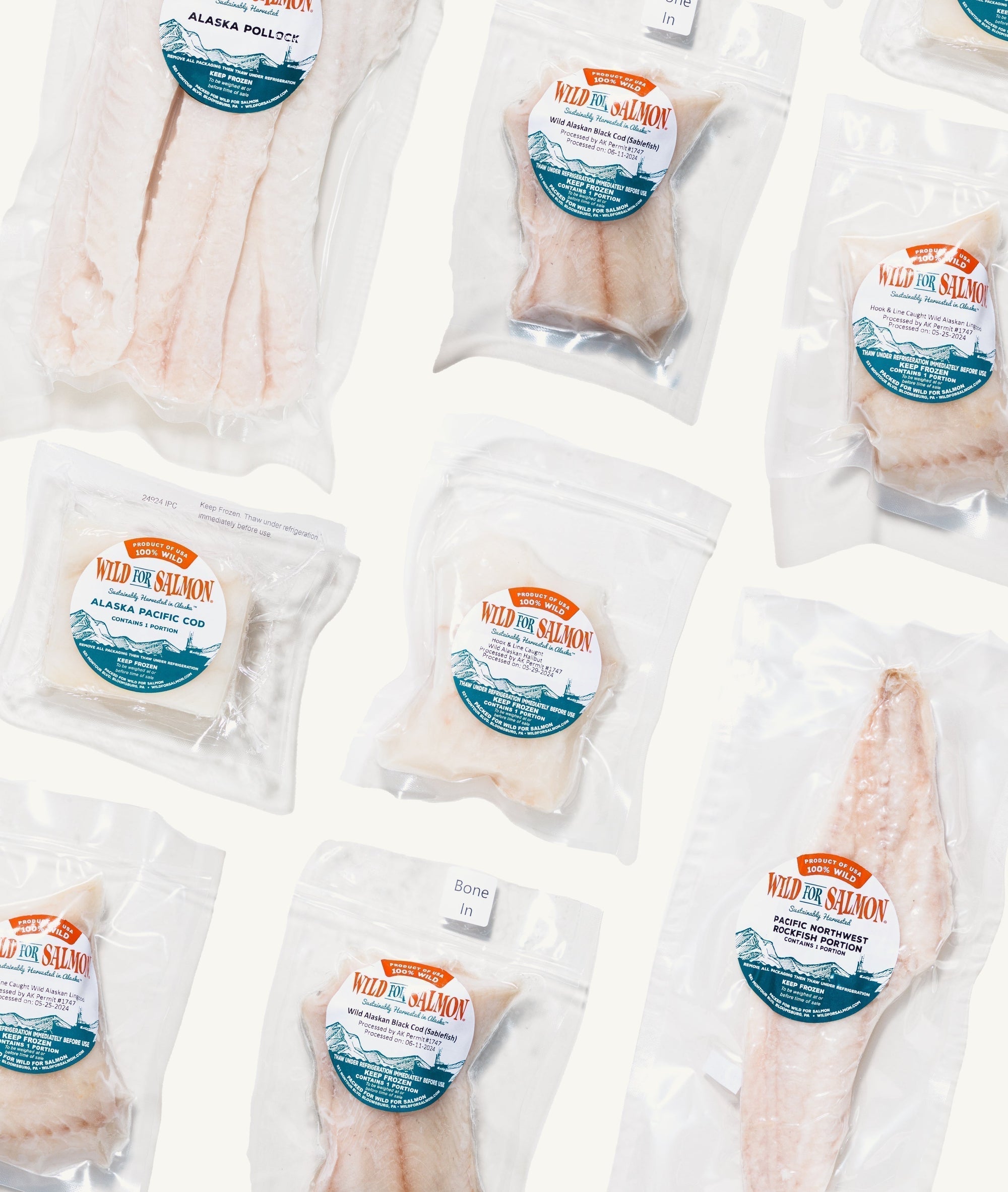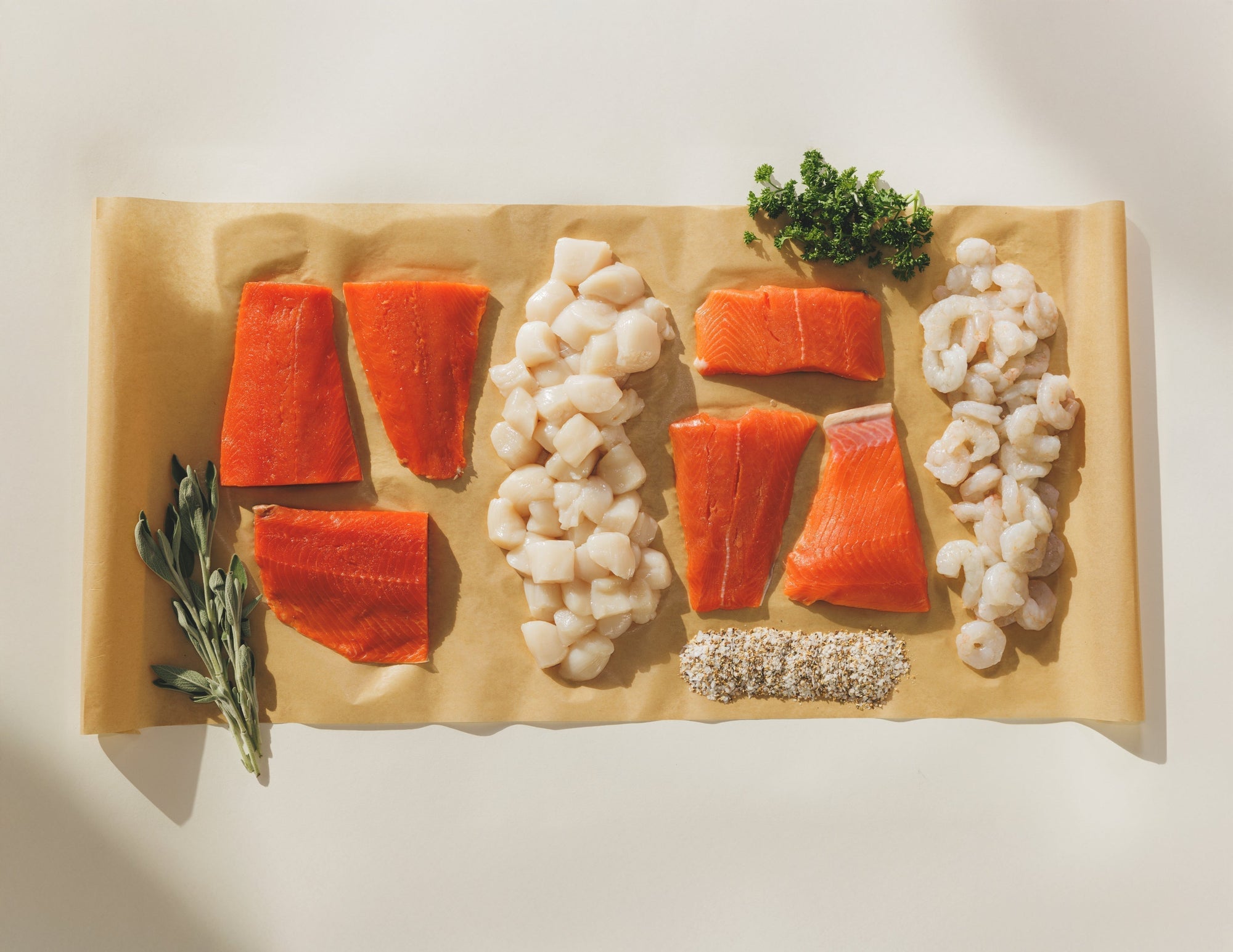 Are you hesitant to buy seafood online? At Wild for Salmon, we understand not everyone is used to buying fish online. That is understandable if you've never done it before and only use online shopping for things like new shelves, specific battery sizes, or buying home appliances. We get it. After all, we started our business selling at local farmer’s markets and to buying clubs. Today, we are grateful to also meet new customers via our online store. Thanks to our attention to detail for how our product is stored and how our fast shipping process, we can get you high-quality, wild-caught fresh fish. From the waters of Alaska to your dinner table!
Are you hesitant to buy seafood online? At Wild for Salmon, we understand not everyone is used to buying fish online. That is understandable if you've never done it before and only use online shopping for things like new shelves, specific battery sizes, or buying home appliances. We get it. After all, we started our business selling at local farmer’s markets and to buying clubs. Today, we are grateful to also meet new customers via our online store. Thanks to our attention to detail for how our product is stored and how our fast shipping process, we can get you high-quality, wild-caught fresh fish. From the waters of Alaska to your dinner table!
Good quality fish starts the second the fish leaves the water, and this care is a priority of the F/V Ava Jane, and our fleet partners. As soon as the fish are aboard, they are dropped into the boat’s refrigerated seawater (RSW) system, which brings the fish’s temperature to a range of 39-32 degrees, meeting quality standards.
Then, within just a few hours, they are brought into the processor where they are flash-frozen, which preserves the freshness of wild seafood. The blast-freezing process maintains the cellular make-up of the fillet and locks in freshness. Check out this page to learn more about the Bristol Bay fishery and how we take great care of our wild Alaska sockeye salmon. When the “fresh” fish sits out in a case on ice in your local grocery store, it’s unlikely that it is good quality seafood that has been caught that day. More likely, it has been thawed from flash frozen and left out in the case, where it will start to lose freshness and flavor.
Just like you wouldn’t get on a boat in the open-ocean with someone you don’t trust, we understand that most want to buy seafood from a trusted, credible source. Take a look at what some of our customers have to say on Trustpilot:
-
"The quality of the salmon is impeccable. The flesh is firm and bright orange/red. Best salmon I have ever purchased." - Jere White
-
"The freshest and best tasting salmon I've ever had. It's a great feeling knowing my freezer is stocked with such high quality salmon! Will continue ordering in the future. Highly recommend!" - Peg Papanek
-
"I have eaten cod for years but until I tried the Wild for Salmon cod I never knew how fresh and delicious cod could be." - William Shakley
First Things First: Quality and Credibility
We believe that that quality and credibility go hand-in-hand, which is why we only partner with trusted fishermen and seafood operations of the highest quality if we aren’t catching the wild seafood ourselves. When buying fish online, the first thing to check is if the seller is reputable. Knowing where your fish comes from and who caught it makes all the difference.
At Wild for Salmon, you get to know your fisherman; our fish is traceable and comes from us, a credible source. You are getting the highest quality seafood from the Alaskan waters of Bristol Bay, and when it comes from other fisheries, the same level of good quality you’ve come to expect from us, comes from our fishing partners. We often write about our partners and their quality practices on our blog in articles like "Where do we get our Crab?".
Another major thing to look for is if the fish is farmed or wild caught. Wild is always going to be better quality. To us, quality also relates to food that is whole and natural, which is why we focus on wild seafood. Wild-caught salmon is one of the last foods that, except for Fish & Game harvest regulations, is 100% not manipulated (and thus unprocessed) by humans. Unlike farm-raised salmon, there are no hormones, antibiotics or additives in our products.
Sustainability, caring for the fish, and caring for the waters they’re caught in tells you a lot about the company too. We here at Wild for Salmon have been sustainably fishing the waters of Bristol Bay for over 18 years, bringing you fresh salmon from our boat to your table since the beginning. Those of you following along with us over the past year or two also know that we are Wildly Devoted to clean water and pristine salmon habitat.
Quality Fish Starts With the Fisherman's Actions
Just like on any other boat, the quality of our seafood starts with us: the fishermen. The freshness, condition and quality of Alaska salmon all begin the second the fish is hauled out of the water, and at Wild for Salmon this is important to us. So much so, that it’s even guaranteed.
After 18 years of commercial fishing and direct marketing sockeye salmon, we have been listening to our customers and adapting our processes and products accordingly. Since getting into the business, Steve has updated his vessel, now the F/V Ava Jane, with a state of the art refrigerated seawater (RSW) system, as well as big and spacious “holds” so the catch is not packed on board too tightly.
The F/V Ava Jane crew also takes the extra step to bleed each and every sockeye salmon as soon as they’re pulled out of the water in order to preserve the meat in its best condition upon refrigeration. Handling is another part of this process that speaks to quality, and our fishermen are trained not to pick up salmon by the tail and to move fish around gently; bruising can start early on and is preventable. All of these important measures are steps our fishermen take out on the water to make the difference on your plate, and match the high-standards to which we hold our fishing partners.
“Fresh” salmon, and other fish called “fresh” (when fresh means never-frozen fish) is a hard commodity to come by in most of the contiguous United States. As New York Times Health Columnist Jane Brody said, “The freshest fish is sold frozen, unless it comes from local waters.” Because we can’t bring the local, pristine and cold waters of Alaska to you, fishermen focused on quality, like us, do the second best and freeze our product with the best technology as soon as possible.
You can read more about our “Fresh vs. Frozen” philosophy in this post. It is also important to know that properly frozen fish is blast-frozen at degrees much lower than your home freezer. As explained here, this process is completed when the fish is at its peak freshness. We do not recommend buying fresh fish off the docks unless you are prepared to eat it within 48 hours.
Once the fish are processed, the importance of handling continues, and our longtime customers know that Wild for Salmon has improved its shipping and delivery throughout the years. Further, we have a small staff that participates in stocking and packing boxes; if something looks awry (like a vac-pack is loose or a product is not 100%), we notice and we don’t sell it. Each box arriving on your doorstep is packed well with dry ice so that the product can arrive just as it left, frozen.
What To Look for Once the Seafood Arrives
We want our customers to feel empowered knowing when they are getting good quality, fresh fish. There’s a few things to look at while unpacking or thawing your fish, some major freshness testers are:

- - Once thawed, the flesh of the fish should be firm and bounce back so that the impression of your finger disappears quickly.
- - Portioned pieces should have a fresh-cut, moist appearance, with no browning or discoloration around the edges.
- - Gaping or tears in fillets that you often see in the grocery cold cases mean they have been left out thawed too long; these fish are less fresh than the just-thawed frozen pieces.
- - Sockeye salmon should be a vibrant, deep red and other salmon species may be pink to red.
The above is true no matter if the fish is purchased as a salmon steak or a salmon fillet. Our salmon products are primarily skin-on because 1) it's delicious and 2) it helps tell the story of the fish and how well it's been handled.
Whitefish
With whitefish (such as cod, rockfish, or halibut) the flesh should be almost translucent – as if you can almost see through it.
Scallops
Scallops should have a firm texture and a distinctly sweet odor. If the shucked (out of shell) scallops smell sour or like iodine - they are likely spoiled. Larger sea scallops (like our Alaska Weathervane Scallops) are also generally creamy white, although they may show some normal light orange or pink color.
Shrimp
In the case of shrimp, the meat should be firm and have a mild odor. If purchased in the shell, the edges of the shells should not be blackened or have black spots.
Crabs
Crabs in the shell should be bright red and have no foul odor. Crab meat is white with red or brown tints, depending on the species or the section of the body it was picked from. Some crab meat is stringy or flaky; this is not a sign of poor quality when ordering crab meat online or picking it up in the store.
Remember that along with the Wild for Salmon Quality Guarantee, we are also available by phone. If buying fish online is new for you, and you would like some guidance, please do not hesitate to reach out. Our customers - both in-store and online - are all important to us, and we are proud to be trusted seafood experts, ready to answer questions and ensure you have the best experience possible when ordering fresh seafood online.



